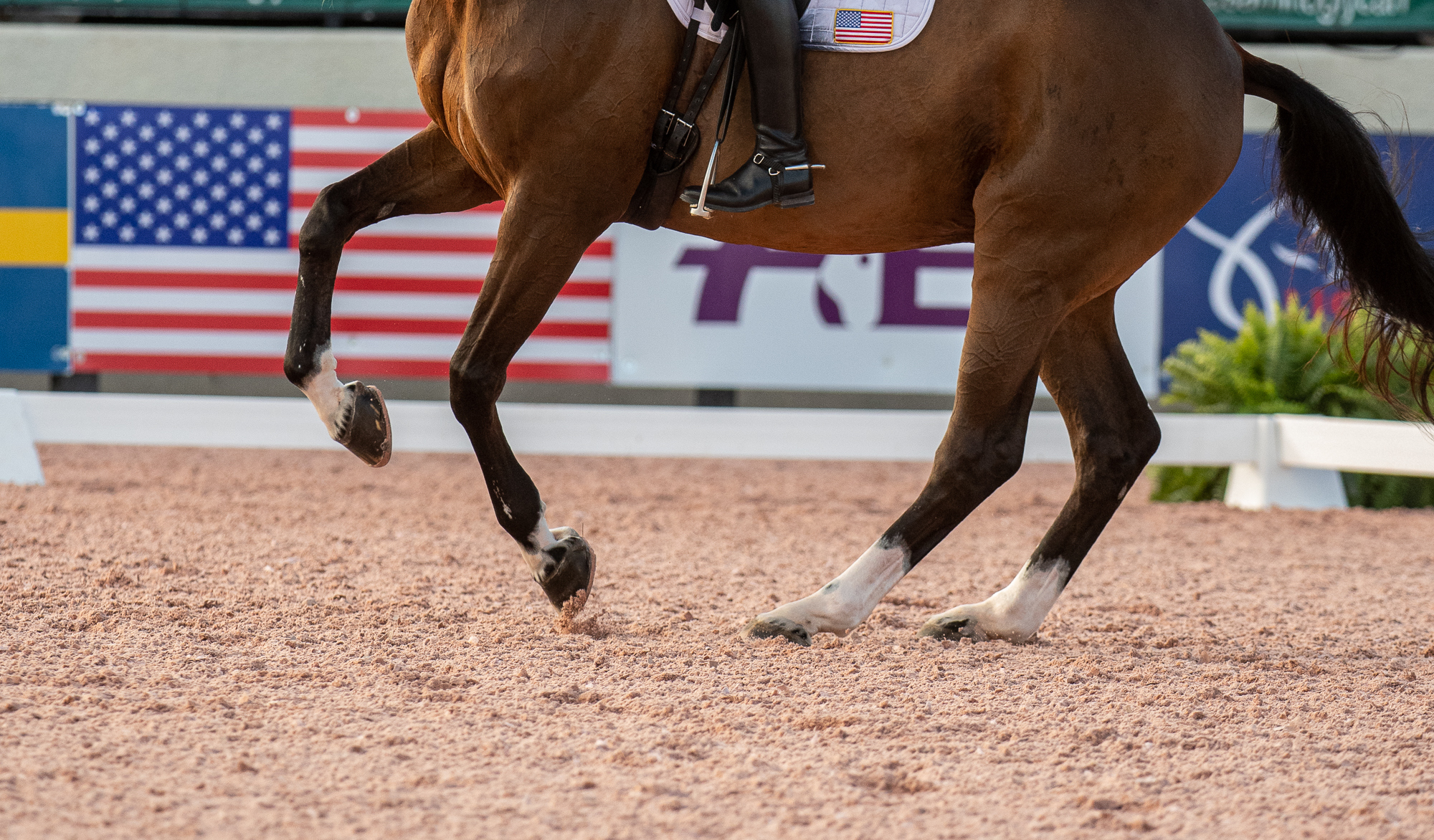Q: I’ve noticed my horse’s canter has become a bit choppy (showing four beats instead of three) particularly when I try to collect the canter. He sometimes even breaks into a walk. How can I get my horse to jump through the canter pirouette better and get more impulsion?
—Name withheld by request

As an Amazon Associate, Dressage Today may earn an affiliate commission when you buy through links on our site. Products links are selected by Dressage Today editors.
A: There are two ways the three-beat rhythm can become unclear in the canter. One is positive dissociation, where the rhythm is broken by the inside hind hoof landing before the outside foreleg touches the ground.
There is some confusion on this subject now with high-speed photography proving that a canter in a tight sitting pirouette cannot be three-beat (See Dr. Hilary Clayton’s 1997 paper, “Comparison of the temporal kinematics of the canter pirouette and collected canter” or David Collins’ Dressage Today article from December 2005.) One should remember, however, that these photographs capture a speed many times greater than the human eye can perceive.
Therefore, the pirouette should still give the impression to the eye that it is a clear three-beat canter rhythm. Think of how a good medium or extended trot gives the appearance of a slower tempo although the tempo remains the same. (See also the FEI and U.S. Equestrian Federation (USEF) rules on this.)
With that aside, faults in the canter rhythm are more often caused by a lack of activity and engagement. Here, the horse’s canter rhythm is broken by the outside foreleg landing before the inside hind leg. Most horses will regain a clear rhythm in the canter when allowed to go in a more forward, energetic manner. Only from a canter with proper impulsion can you begin to school the pirouette canter. You must avoid a heavy hand as it will discourage your horse from coming energetically forward and through.
Before you work on improving the canter in anticipation of the canter pirouette, work to refine the walk pirouette. Faults in your horse’s balance in the canter pirouette often can be seen in the walk pirouette. Remember that from any step in a pirouette, your horse should be able to go forward on any line you choose. The line your horse comes out on should never be one where the haunches are ahead of the shoulders, yet your horse should still be concave around your inside leg and accepting of your outside rein.
Before schooling the canter pirouettes, you must have well established the pirouette canter. Here are two exercises to help.
Canter Exercise
1. In a canter with good impulsion, travel down the long side.
2. Make an easy corner and continue forward onto a 20-meter circle on the short side.
3. While on the circle, begin to collect your horse while keeping a slight shoulder-fore positioning. Make sure your inside leg reminds him to stay energetically connected to the outside rein.
4. Ask for only a few strides of collection before you reinvigorate. As the collection becomes more reliable, increase the number of collected strides.
5. After your horse is able to collect on the circle without losing activity and rhythm, you can begin to gradually make the circle smaller. To keep the activity and engagement of the outside hind leg, ask for a slight haunches-in. A clever horse will offer to make the figure smaller and slower or offer to increase the bend/angle. Do not allow this to happen.
6. At the first sign of your horse struggling (e.g., trying to flatten, losing energy or the purity of the canter) immediately reinvigorate the canter while opening the circle in shoulder-fore positioning. Do this at first with no thought toward the canter pirouette. In losing the purity, your horse is showing he cannot yet sustain that degree of collection. This is very common. You must take care to always keep your horse energetically forward and through.
7. Alternate between haunches-in and shoulder-fore while spiraling in and out until your horse is comfortable with the changes in his balance, meaning no loss of activity or clear rhythm. Do not let him anticipate the canter pirouette.
Counter-Canter Exercise
Having a well-defined rhythm in the counter canter is often easier for riders because it takes more effort and awareness to keep both the lateral and longitudinal balance.
1. With good energy in the counter canter, begin a circle in the middle of the arena.
2. As on the circle in true canter, begin to collect your horse by asking him to come progressively more collected. Then reinvigorate the canter forward on the circle.
3. Once you have done this several times without wavering from the circle line, ask on the centerline for a 15-meter circle to the outside in true collected canter with shoulder-fore positioning. It is important to remember that a horse is narrower in front than he is behind. When asking him to take the weight behind in high collection, if he can displace the haunches to get an even wider base of support, he often will. Therefore, shoulder-fore positioning is vital.
When your horse is solidly able to perform this exercise, you can begin to gradually make the 15-meter circle in true canter smaller to a 10-meter circle. As you decrease the size of the circle, increase the degree of collection. As previously noted, the clever horse will often try to push the haunches in. Do not let him. Insist that he stay in the shoulder-fore positioning. By now it should be unnecessary to keep the haunches-in positioning as done earlier to retain the activity of the outside hind leg.
Once you are able to ride a smaller volte (and only then), you can ask for no more than a stride or two of canter pirouette from the true canter volte. As in the walk pirouette mentioned above, you should be able to come out on any line immediately while maintaining the balance and activity. When this is solid, decrease the size to a working pirouette. Only occasionally should you ride them smaller as you must in the show ring.
All of the above you should do while paying great attention to your horse being light in the hand. If your horse becomes strong in the hand, you know he is not yet strong enough behind. If you become strong in your hand, you will kill the activity you worked so hard to generate.
Don’t be discouraged if you don’t see results right away. Getting the pirouette canter is the difficult part. Once you have your horse reliably maintaining six to eight strides of pirouette canter, the canter pirouette becomes nearly effortless.
Click here to read more articles from Martin Kuhn.
This article is from the Dressage Today archives.

Martin Kuhn is a U.S. Dressage Federation (USDF) Certified Instructor through Fourth Level. In 2009, he rode Manhattan to an 8th place finish at the Developing Horse Championships. In 2010, on Greystoke, he won the 5- and 6-Year Old Suitability class at Dressage at Devon. He trains and teaches at StarWest in Illinois (starwestonline.net).











